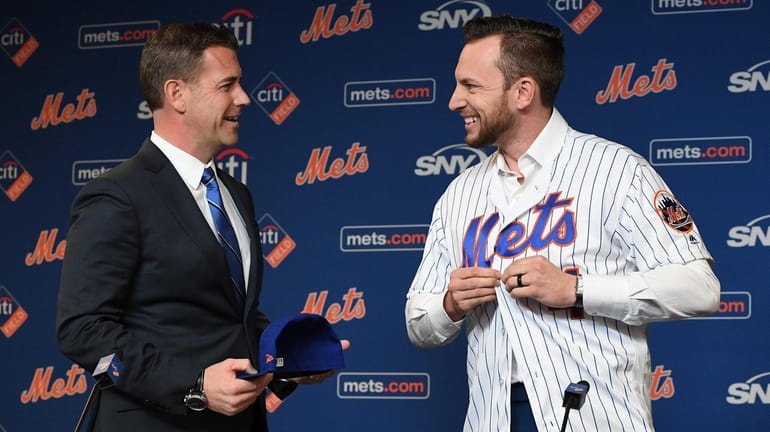Face it, Brodie: Jed Lowrie signing, handling of injury, one big swing and miss for Van Wagenen's Mets

Mets general manager Brodie Van Wagenen welcomes Jed Lowrie to the club during a press conference at Citi Field on Wednesday, Jan. 16, 2019. Credit: Kathleen Malone-Van Dyke
Looseness of the knee. That’s how Brodie Van Wagenen described Jed Lowrie’s situation.
Granted, it’s no “violent fall in which he stepped into a hole” – the way Van Wagenen related Yoenis Cespedes’ fateful encounter with a wild boar a year ago – but the moment the Mets general manager uttered those words Thursday, Lowrie’s future this season went from dire to all but hopeless.
That’s why all the other words Van Wagenen said didn’t quite jibe with reality.
Words like: “We think the player can help us.” Or his proclamation that Lowrie could be major-league ready if he finds a way back to the field. You know, if he can figure out how to run the bases, or play defense, or function without the giant brace that makes him look bionic, all in T-minus two months.
“He was major-league ready offensively,” Van Wagenen said confidently of Lowrie’s summer camp.
Asked if he regretted the two-year, $20 million deal, the Mets general manager acknowledged that the returns have been disappointing, but also doubled down. It was the right thing to do at the time, he said. Even now, the Mets aren’t putting Lowrie on the 45-day injured list.
“We’re seeing now, and we saw it last year as well, the importance of versatility. And Jed being a switch hitter that could play all [four] infield positions was a strategic move to give us depth and versatility in the infield,” he said. “It’s important then. It’s important now.”
Actually, what’s important right now is Lowrie’s diagnosis – officially dubbed “PCL laxity,” or looseness of the posterior cruciate ligament, the ACL’s burlier big brother. The PCL links the thigh bone to the shin, and an injury can sideline sufferers for several weeks or months, according to the Mayo Clinic. Lowrie, meanwhile, feels fine when he wears the large brace, Van Wagenen said, but the Mets need him to transition to the smaller brace to play, and that’s when the pain sets in. He’s already been strengthening the area around the knee for months, to little avail.
Two doctors will be evaluating his situation in the coming days, including discussing surgical options. At that point, what everyone seems to know – and what Van Wagenen is loath to admit – could prove to be true: Lowrie’s tenure as a Met will be all but over.
If that’s the case, he’ll go down as one of Van Wagenen’s biggest missteps – a big-ish contract, given to an older player, signed with more than its fair share of pomp, that ended in seven at-bats, six strikeouts, no hits and the world’s most expensive base on balls.
Let’s be clear: Bad contracts happen. When Lowrie had his big introductory news conference – an event that feels like it was approximately three eons ago – no one could have foreseen what we know now. The physical apparently didn’t show these issues, and though he was 34 at the time, he was also coming off his first All-Star season. Van Wagenen said he doesn’t think the Mets missed it, and it’s entirely possible that Lowrie acquired his injuries after the ink was already dry.
Everything that came after that, though – that’s on the Mets. For months, Lowrie’s maladies seemed shrouded in mystery. It was a knee…something. The timeline was fluid. He was on his way back and then he wasn’t. When Lowrie did return to the clubhouse for nine games last September, he looked gaunt, and at times ginger.
Now, it’s unclear whether Van Wagenen handled it the way he did because the Mets simply didn’t know what was actually going on. But it’s equally as clear that, at times, the GM was selling something of a far-fetched dream – the dream that Lowrie, after months and months of pain and even immobility – would pop back into a baseball game and be the switch-hitting, Swiss Army infielder of the Mets dreams. What’s surprising, though, is that he’s still doing it, after all this time.
And that’s a tough look for Van Wagenen, who still hasn’t shed some of the stigma that’s come from being a former agent. The contract was a mistake, whether they knew it at the time or not. Instead, Van Wagenen is holding on: “The goal would be to get him back to contribute,” he said of Lowrie. Asked if that was realistic, he said it was possible.
Van Wagenen’s missteps were further highlighted (some more) in the ninth inning of Thursday’s loss to the Red Sox, when Edwin Diaz again struggled with his control, again let up a ninth-inning run, and again cast doubt on the ill-fated moves that brought him and Robinson Cano to Flushing, and sent Jarred Kelenic to the Mariners. That, too, will get no mea culpa.
Call it stubbornness, call it hope, or call it a sales pitch, but no one is buying it anymore.

